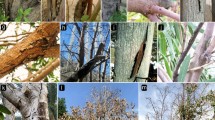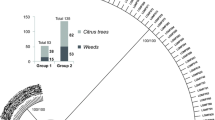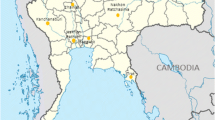Abstract
Hibiscus syriacus, as a national flower of Korea, is most popularly used for ornamental purposes and includes numerous cultivars, and it is widely planted in temperate zones that feature hot summers. We investigated Choanephora flower rot on H. syriacus from 2012 to 2014 in Korea and Japan and confirmed Choanephora infection in several localities in both countries. Here, our objectives were to identify the main causal agent of Choanephora flower rot on H. syriacus and describe its morphological and molecular characteristics. We identified 44 out of 50 isolates as Choanephora cucurbitarum and the remainder as C. infundibulifera based on morphological characterization and phylogenetic analysis. The sequences of the internal transcribed spacer region (ITS) of ribosomal DNA and the D1/D2 region of the large subunit (LSU) rDNA of examined isolates were compared with sequences obtained from GenBank, and the analysis of the results revealed 100 % identity with the corresponding sequences of C. cucurbitarum and C. infundibulifera strains. Classification of the Choanephora species performed here according to the key described by Kirk (1984) corresponded with the results of the phylogenetic analysis of this study. Through intraspecific and interspecific mating tests, the characteristics of zygospore were described in details. Pathogenicity tests using both species showed the same symptoms, causing blossom blight and soft rot on the flowers, which were identical to those observed in the field. All identified causal agents of Choanephora rot were indeed Choanephora species, where C. cucurbitarum was identified in the majority, while the others were in the minority of examined samples.





Similar content being viewed by others
References
Abdel-Motaal, F. F., EI-Sayed, M. A., EI-Zayat, S. A., Nassar, M. S. M., & Ito, S. I. (2010). Choanephora rot of floral tops of Hyoscyamus muticus caused by Choanephora cucurbitarum. Journal of General Plant Pathology, 76, 358–361.
Attorre, F., Bruno, M., Francesconi, F., Valenti, R., & Bruno, F. (2000). Landscape changes of Rome through tree-lined roads. Landscape and Urban Planning, 49, 115–128.
Barnett, H. L., & Lilly, V. G. (1956). Factors affecting the production of zygospores by Choanephora cucurbitarum. Mycologia, 48, 617–627.
Benny, G. L. (2012). Current systematics of Zygomycota with a brief review of their biology. In J. K. Misra, P. Tewari, & K. Deshmukh (Eds.), Systematics and evolution of fungi (pp. 55–105). Enfield: Science Publishers.
Blakeslee, A. F., Cartledge, J. L., Welch, D. S., & Bergner, A. D. (1927). Sexual dimorphism in Mucorales. I. Intraspecific reactions. Botanical Gazette, 84, 27–50.
Chang, C. W., Yang, H. C., & Leu, L. S. (1984). Zygospore formation of Choanephora cucurbitarum. Transactions of the Mycological Society of Japan, 25, 67–74.
Cheng, Y. L., Lee, S. C., Harn, H. J., Huang, H. C., & Chang, W. L. (2008). The extract of Hibiscus syriacus inducing apoptosis by activating p53 and AIF in human lung cancer cells. The American Journal of Chinese Medicine, 36, 171–184.
Couch, J. N. (1925). A new dioecious species of Choanephora. The Journal of the Elisha Mitchell Scientific Society, 41, 141–150.
Crous, P. W., Verkley, G. J., Groenewald, J. Z., & Samson, R. A. (2009). Fungal biodiversity. Utrecht: CBS-KNAW Fungal Biodiversity Centre.
Currey, F. (1873a). On a new genus in the order Mucedines. Botanical Journal of the Linnean Society, 13, 333–334.
Currey, F. (1873b). Note on Cunninghamia infundibulifera. Botanical Journal of the Linnean Society, 13, 578.
Farr, D. F., & Rossman, A. Y. (2015). Fungal databases, Systematic Mycology & Microbiology Laboratory, ARS, USDA. http://nt.ars-grin.gov/fungaldatabases/. Accessed 12 February 2015.
Hsu, H. Y., Chen, Y. P., Shen, S. J., Hsu, C. S., Chen, C. C., & Chang, H. C. (1986). Oriental material medica: a concise guide. Long Beach: Oriental Healing Arts Institute.
Huang, K. C. (1999). The pharmacology of Chinese herbs (2nd ed.). NY: CRC Press.
Hyde, K. D., Nilsson, R. H., Alias, S. A., Ariyawansa, H. A., Blair, J. E., Cai, L., et al. (2014). One stop shop: backbones trees for important phytopathogenic genera: I (2014). Fungal Diversity, 67, 21–125.
Johnson, U. E., Ishoro, A. P., Effiong, U. S., Aniedi-Abasi, M., Ntui, O. E., & Johnson, U. I. (2014). Determination of pathogenicity of Choanephora cucurbitarum (Berkeley and Ravenel) Thaxt., amongst commonly cultivated vegetables in Calabar, Cross River state, Nigeria. International Journal of Phytopathology, 3, 55–61.
Kagiwada, S., Kayano, Y., Hoshi, H., Kawanishi, T., Oshima, K., Hamamoto, H., et al. (2010). First report of Choanephora rot of ice plant (Mesembryanthemum crystallinum) caused by Choanephora cucurbitarum in Japan. Journal of General Plant Pathology, 76, 345–347.
Kim, K. D., & Lee, E. J. (2005). Potential tree species for use in the restoration of unsanitary landfills. Environmental Management, 36, 1–14.
Kirk, P. M. (1984). A monograph of the Choanephoraceae. Mycological Papers, 152, 1–61.
Kucharek, T., & Simone, G. (1980). Wet rot of vegetable crops. Florida Cooperative Extension Service, Institute of Food and Agricultural Sciences, University of Florida.
Kwon, J. H., & Park, C. S. (2002). Flower rot of cotton rose (Hibiscus mutabilis) caused by Choanephora cucurbitarum. Research in Plant Disease, 8, 55–58.
Naganishi, H., & Kawakami, N. (1954). On Choanephora Currey in Japan. Bulletin Faculty of Engineering, Hiroshima University, 4, 163–175.
O’Donnell, K. (1993). Fusarium and its near relatives. In D. R. Reynolds & J. W. Taylor (Eds.), The fungal holomorph: mitotic, meiotic and pleomorphic speciation in fungal systematics (pp. 529–580). Wallingford: CAB International.
Paoletti, E., Ferrara, A. M., Calatayud, V., Cervero, J., Giannetti, F., Sanz, M. J., et al. (2009). Deciduous shrubs for ozone bioindication: Hibiscus syriacus as an example. Environmental Pollution, 157, 865–870.
Park, J. S. (1961). Fungous Diseases of Plants in Korea (2). Spec. Bull. No. 2, Chungnam National University, Taejon, Korea.
Park, J. H., Cho, S. E., Han, K. S., Lee, S. H., & Shin, H. D. (2014). First report of Choanephora blight caused by Choanephora infundibulifera on Hibiscus rosa-sinensis in Korea. Plant Disease, 98, 1275.
Park, J. H., Cho, S. E., Choi, I. Y., & Shin, H. D. (2015a). First report of Choanephora rot of okra caused by Choanephora cucurbitarum in Korea. Journal of Phytopathology, 163, 503–506.
Park, J. H., Cho, S. E., Han, K. S., Kim, B. S., & Shin, H. D. (2015b). First report of Choanephora rot caused by Choanephora cucurbitarum on Hosta plantaginea in Korea. Plant Disease, 99, 158.
Roberts, P. D., Urs, R. R., Kucharek, T. A., Semer, C. R., Benny, G. L., & Pernezny, K. (2003). Outbreak of Choanephora blight caused by Choanephora cucurbitarum on green bean and pepper in Florida. Plant Disease, 87, 1149.
Saccardo, P. A. (1891). Sylloge Fungorum, 9, 1–1141, Italy.
Saroj, A., Kumar, A., Qamar, N., Alam, M., Singh, H. M., & Khaliq, A. (2012). First report of wet rot of Withania somnifera caused by Choanephora cucurbitarum in India. Plant Disease, 96, 293.
Seo, S. T., Park, J. H., Cho, S. E., & Shin, H. D. (2013). First report of leaf spot caused by Corynespora cassiicola on rose of Sharon in Korea. Plant Disease, 97, 847.
Shi, L. S., Wu, C. H., Yang, T. C., Yao, C. W., Lin, H. C., & Chang, W. L. (2014). Cytotoxic effect of triterpenoids from the bark of Hibiscus syriacus. Fitoterapia, 97, 184–191.
Song, W. D. (2004). Hibiscus syriacus. Seoul: Semyoungseogwan.
Tamura, K., Stecher, G., Peterson, D., Filipski, A., & Kumar, S. (2013). MEGA6: molecular evolutionary genetics analysis version 6.0. Molecular Biology and Evolution, 30, 2725–2729.
Thaxter, R. (1903). A new England Choanephora. Rhodora, 5, 97–102.
The Korean Society of Plant Pathology. (2009). List of plant diseases in Korea. 5th ed., Seoul.
Walther, G., Pawlowska, J., Alastruey-Izquierdo, A., Wrzosek, M., Rodriguez-Tudela, J. L., Dolatabadi, S., et al. (2013). DNA barcoding in Mucorales: an inventory of biodiversity. Persoonia, 30, 11–47.
White, T. J., Bruns, T., Lee, S., & Taylor, J. (1990). Amplification and direct sequencing of fungal ribosomal RNA genes for phylogenetics. In M. A. Innis, D. H. Gelfand, J. J. Sninsky, & T. J. White (Eds.), PCR protocols: a guide to methods and applications (pp. 315–322). San Diego: Academic Press.
Wolf, F. A. (1917). A squash disease caused by Choanephora cucurbitarum. Journal of Agricultural Research, 8, 319–328.
Yoo, I. D., Yun, B. S., Lee, I. K., Ryoo, I. J., Choung, D. H., & Han, K. H. (1998). Three naphthalenes from root bark of Hibiscus syriacus. Phytochemistry, 47, 799–802.
Yu, M. Q., & Ko, W. H. (1996). Mating type segregation in Choanephora cucurbitarum following sexual reproduction. Canadian Journal of Botany, 74, 919–923.
Yun, B. S., Ryoo, I. J., Lee, I. K., Park, K. H., Choung, D. H., Han, K. H., et al. (1999). Two bioactive pentacyclic triterpene esters from the root bark of Hibiscus syriacus. Journal of Natural Products, 62, 764–766.
Acknowledgments
This work was financially supported by the National Institute of Biological Resources (NIBR) of Ministry of Environment, Korea (1834-302, Graduate Program for the Undiscovered Taxa of Korea).
Author information
Authors and Affiliations
Corresponding author
Rights and permissions
About this article
Cite this article
Park, JH., Cho, SE., Suyama, M. et al. Identification and characterization of Choanephora spp. causing Choanephora flower rot on Hibiscus syriacus . Eur J Plant Pathol 146, 949–961 (2016). https://doi.org/10.1007/s10658-016-0972-0
Accepted:
Published:
Issue Date:
DOI: https://doi.org/10.1007/s10658-016-0972-0




